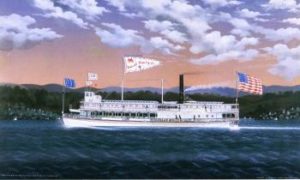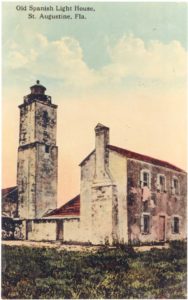For 140 years, the St. Augustine Lighthouse has presented its beacon to sailors along the nation’s First Coast. It’s seen keepers and families come and go, witnessed the construction and removal of auxiliary structures, and adapted to new and innovative technologies, all while the community around it expands and evolves. This series of blog posts will explore that history, 20 (or so) years at a time.
Pre – 1874
The story of the current St. Augustine Lighthouse begins with its predecessor. The current lighthouse in St. Augustine is not the original St. Augustine Lighthouse. The Spanish constructed the tower that became the first lighthouse in 1737. They used a naturally occurring stone called coquina to construct the original tower. The coquina tower replaced wooden watchtowers the Spanish built dating back to the beginnings of Spanish Florida.
A map of Francis Drake’s 1586 raid on St. Augustine reveals the presence of a small tower on Anastasia Island. The map refers to the tower as “a Beacon or high scaffold standing on the sand hills, wherein the Spaniards did use to discover the ships at sea.” The coquina tower continued this watchtower tradition until the United States acquired Florida in the Adams-Onís Treaty (1821). The U.S. Government then set to work illuminating the newly added coastline.
St. Augustine, with its preexisting tower, was a logical place to start. In 1823, John Rodman, Collector of St. Augustine, wrote to Stephen Pleasonton, Fifth Auditor of the U.S. Treasury, that despite the tower’s presence, “…it was never built for a lighthouse or used as one, but merely a look-out-house. The location is well suited…but a great proportion of the tower, nearly one half, is not sufficiently strong to bear any greater elevation either if wood or stone work.” Congress appropriated $5,000 to retrofit and complete the lighthouse and awarded the contract to Elias Wallen who reported on March 25, 1824 that the lighthouse was operational and that Winslow Lewis fit the new beacon with “ten patent lamps and ten fourteen inch reflectors.”
John (Juan) Andreu became first keeper of Florida’s first official U.S. lighthouse in St. Augustine. His Menorcan parents Antonio and Agueda arrived in Florida as indentured servants at Dr. Andrew Turnbull’s New Smyrna plantation in 1768 and traveled to St. Augustine by foot where they settled when Turnbull abandoned his settlement in 1777. The Menorcans became a visible minority in the city, contributing to its maritime culture as fishermen, pilots, and lighthouse keepers. Juan was the first of many Menorcan keepers at the St. Augustine Lighthouses. As the first, he also holds the distinction of being the first Hispanic-American to serve in the Coast Guard and the first to oversee a federal installation of any kind.
Juan Andreu served as keeper until 1845 and the records are unclear as to who took over and served as lighthouse keeper from 1845 to 1849. John (Juan) Carrera served as keeper from 1849 until his death in 1853. Robert Mickler then served temporarily for 6 months before Juan Andreu’s cousin Joseph (José) Andreu took over lightkeeping duties in 1854. Joseph attended the light until tragedy struck when the scaffolding from which he was painting the tower failed. The December 10th, 1859 edition of the St. Augustine Examiner tells that Joseph…
“…first struck the roof of the oil room about thirty feet below, whence he glanced off and struck the stone wall which encloses the Light House, and thence to the ground…killing him instantly.”
Joseph’s wife Maria Mestre de los Dolores Andreu was appointed keeper in place of her deceased husband, an appointment the St. Augustine Examiner called “a just and kind recognition of the services of her much respected deceased husband and as a just provision for the support of a poor and deserving widow.” The newspaper applauded the “kindly sympathy shown in this appointment” triumphing over the usual “political reasons” for hiring new keepers. The Coast Guard recognizes Maria Andreu as the first Hispanic-American woman to serve in the Coast Guard or its predecessor services and the first to command a federal shore installation.
Maria served as lighthouse keeper in St. Augustine until authorities darkened the tower during the Civil War in an effort to hinder the Union Navy off Florida’s coast. As the city’s Collector of Customs, Paul Arnau oversaw the removal of the lighthouse Fresnel lens in January 1861, per Confederate orders. Serving as mayor of St. Augustine from November 1861 to March 1862, Arnau resigned rather than surrender the city to Union forces.

Painting of USS Isaac Smith by James Bard
Courtesy of The Athenaeum
Northern troops arrested Arnau and sequestered him on the Union gunboat Isaac Smith until he revealed the location of the lighting mechanisms for the St. Augustine light and other lighthouses in the area including Cape Canaveral.
Relit on June 1st, 1867, the old tower served St. Augustine until its proximity to the eroding shoreline threatened its ability to serve its maritime community. A taller, sturdier modern tower was needed.
Paul Zielinski is Director of Interpretation for the St. Augustine Lighthouse & Museum. He received his master’s degree in Public History from the University of West Florida and joined the lighthouse family in 2011.


